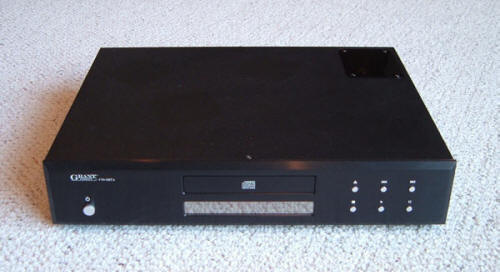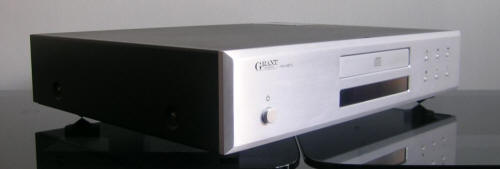
You are reading the older HTML site
Positive Feedback ISSUE
40november/december 2008
grant fidelity
CD-327A tubed CD player
as reviewed by Kent Johnson
|
KENT JOHNSON'S SYSTEM
LOUDSPEAKERS
ELECTRONICS
SOURCES
CABLES
ACCESSORIES SECOND SYSTEM
LOUDSPEAKERS
ELECTRONICS
SOURCE
CABLES
ACCESSORIES
|
Grant Fidelity is a Canadian company that manufactures audio equipment in China. They sell their products directly. I got a chance to see and hear a number of their products at Rocky Mountain Audio Fest and I was very impressed by the sound, the build quality, and the prices. I will be reporting on a very interesting 300B tube integrated amp in the near future. I also have a power conditioner and some cabling to listen to as well.
I have been listening to the Grant Fidelity CD-327A tubed CD player for a months now. Before discussing what I have heard, I need to point out that I received no information with the CD-327A. (This is not a gripe or complaint, just the facts.) I did not worry about this because I knew that I could go to GF's web site for information if I needed to and could always contact them as well. Besides, the CD player is really basic in terms of its controls, so what is there that needs explaining? Even a reviewer should be able to run this player.
So I listened to the CD-327A just as it came out of the box, nor did I go to the GF web site until I finished writing my initial draft of this review. While looking for the CD-327A's weight, I discovered that it offered user-selectable upsampling rates. This was interesting. According to the web site, the CD-327A offers upsampling rates of 44.1, 88.2, or 176.4 KHz, selectable from the remote.
Furthermore, it turns out that changing upsampling rates is child's play once you know they exist. Press Stop, then Display on the remote. The CD-327A toggles through the three rates; 176.4 KHz is the default rate and that is what I had used for all of my listening! This means there is more to this player than I had previously thought. I will play with the other upsampling rates while reviewing the amplifier and let you know what, if anything, I hear.
Description
The CD-327A is a normal-sized CD player, measuring 17 by 14 by 4.5 inches, WDH, and it is very sturdily constructed. It weighs 11 Kilograms, about 24 pounds, and sells for $949.
Its exterior is made of impressively thick sheet metal covered with a black crackle finish. The front fascia is 10mm thick aluminum. On the bottom are aluminum cones which act as the unit's feet. Once this unit was sitting on my equipment rack, it felt like the proverbial immovable object.
The rear of the unit has an IEC electrical socket and three very good quality RCA jacks. Two of these are for Right/Left output; the third is a coaxial digital output.
The front of the unit has only seven small silver buttons. To the left of the display is the on/off switch. To the right are the Open/Close and Track Back/Track Forward buttons. Below them are the Stop, Play, and Pause buttons. The drawer is in the middle and below it is the liquid crystal display; it provides time and track information. It can also display the upsampling rate and whatever repeat setting might be in use.
There is a smoked plastic window at the right rear of the CD-327A through which can be seen the two Chinese 12AX7A tubes in the output stage. I took the cover off and saw quite a few high quality parts inside; Solen and other film capacitors were visible.
The metal remote is long, thin, and quite substantial with twenty buttons laid out in two rows of ten. Starting at the output end, there are buttons for Open/Close and A-B repeat. Below them are ten numerical buttons. These access the CD tracks directly—push 2 then 3 and you are at track 23. No having to hit a 10+ or other similar button first.
Next are the buttons for Display and Repeat. When the CD-327A is playing, Display only changes the way the timing of the tracks is presented. Repeat allows the repeat of a given track or an entire disc.
The bottom eight buttons replicate the controls on the front of the player while adding forward and backward Track Search buttons.
If it was up to me, I would not have organized the buttons the way Grant Fidelity had, but the layout became intuitive the more I used it.
The one thing that I found disconcerting about the CD-327A's construction was its flimsy drawer. I caught the corner of it several times while reaching for the Play button and the amount of flexing and noise that resulted did not inspire confidence. Still, costs have to be cut somewhere and, in any case, it worked fine.
The only other thing that struck me as somewhat odd was the lack of any sort of dimmer or on/off switch for the display. This is not a necessary feature but, since the display is bright and too small to read from any reasonable listening position, it seems like turning it off should be an option.
The CD-327A is not going to win any awards for styling, design, or feature count but I think its solid construction will appeal to those audiophiles who value a substantial, well-built component at a reasonable price. It has everything necessary to play CDs and that is what really matters. It also has a tubed output stage and may very well be one of the least expensive players on the market offering such a feature.
So how does it sound?

Listening
I placed the CD-327A into my main system in place of my Sony SCD-C333ES SACD player. I connected a set of DH Labs Revelation cables to the analog outputs and my digital cable to its coaxial output. This allowed me to compare the output of the CD-327A to the output of my Cullen Circuits DAC by simply switching between inputs on my preamp. I did the vast majority of my listening with the CD-327A as a CD player although it proved to be an excellent transport as well. I started doing critical listening to the CD-327A once it had about 100 hours on it (much of this was on a pair of Xavian XN 270 loudspeakers—review in progress).
The sound I heard through the CD-327A was excellent with every CD I listened to.
Trio Mediaeval's Folk Songs CD offered some of the most exquisitely beautiful female voices I have ever heard through my system. The locations of the three singers and their sparse accompaniment were revealed within the soundstage with no ambiguity whatsoever. The sense of space surrounding them was tangible. Low level reverberations, mouth and breathing sounds, and other subtle nuances added to the sense of being in the same room with the singers. While there was a lot of detail present, and the dynamics of their voices were excellent, the three singer's voices were never in any way shrill or aggressive. (ECM New Series 2003 B0009888-02)
The ARC Choir's Walk with Me CD provided the same sense of involvement, albeit with a larger ensemble. Voices appeared all over the soundstage—which extended outside of the speakers—and were easy to follow whether from a single individual or a group of singers. This recording has the most realistic handclaps that I think I have ever heard. The sense of being in the church with the singers—and having a very good seat—is an indication of both the quality of the recording and its playback. (Mapleshade 04132)
I have not listened to Wilco's Yankee Foxtrot Hotel in so long that it was essentially a new recording for me. While the lyrics do not make a great deal of literal sense, the ability to respond to them emotionally was enhanced by the CD-327A. This CD was both mellower than I remember it and far more coherent. I also remembered this CD as being a somewhat disjointed collection of sounds appearing within a smaller soundstage. Through the CD-327A there is an organization to everything that contributes to an overall emotional response. For me, this CD's combination of music and lyrics simply bypasses the logical portion of the brain and goes straight to the emotional center. I have been intending to listen to this CD again for some time and doing so while I had the Grant Fidelity player in the system was really good timing. (Nonesuch 79669-2)
James Taylor's Covers, Yo Yo Ma's Silk Road Journeys, Martina McBride's Timeless, Frank Sinatra's Wee Small Hours, and Everything But the Girl's Acoustic all sounded as good as or better than I have ever heard them. There was loads of detail accompanying the dynamic and well defined bass, gorgeous and eloquent midrange, and clean, airy treble. Soundstage width and depth were outstanding.
I compared the output of the CD-327A to that of my Cullen Circuits DAC ($1600) using the 327A as a transport.
The presentation of the Cullen DAC was very slightly more forward than that of the CD-327A. This resulted in a somewhat greater sense of separation between, for example, a solo vocalist and a musician farther back in the soundstage. Hearing this difference depended heavily upon the quality of the recording and the type of music. Ninety-five percent of the time, I could not hear any difference between the two set ups.
I should note here that I did all my listening to the CD-327A was with an upgraded power cord supplied by Grant Fidelity. The PC-1.5 AC cord costs $149. I did this for a couple of reasons. First, the price of this cord is reasonable enough to consider it a necessity, not an upgrade. Second, it's a matter of break-in time. Breaking-in the CD player with its stock cord, then changing cords and having to worry about break-in all over again would result in this review being finished around Easter. To me it made sense to take advantage of having the upgrade cord to begin with.
Get tubes already!
The most distinctive feature of the CD-327A is its tube output stage which uses two Chinese 12AX7 tubes visible through a smoked plastic window on the right rear of the player.
To be honest, I heard absolutely nothing to indicate that this CD player had tubes in it other than that the sound itself was exceptionally good. I would not buy this CD player with the expectation that its tubes will warm up your system or fix an edgy midrange or treble. I found it to be a very neutral-sounding player.
There is, of course, the possibility that tube rolling will improve the performance of this player somewhat further. For me though, I would be in no hurry to do such a thing as the stock player sounded excellent, and it was totally silent. You could change tubes, introduce noise, and mess up the sound just as easily as you could improve it. Grant Fidelity offers a tube upgrade for $100, which is the way I would go, but only after getting familiar with the sound of the stock player.
Summary
What we have here is a minimalist, very well made, tubed CD player. Its sound quality is excellent. At the CD-327A's price of $949, I think it is definitely a bargain. As mentioned, I did use GF's upgrade power cord, so think of it as an $1100 CD player if you wish. It's still a bargain.
It seems to me that Grant Fidelity has made all the right choices in producing this player. Sure, the drawer is flimsy, but it does not appear to affect the sound quality. The chassis on the other hand, which should affect the sound quality, is solid and heavy. There are less features than found on competing player, but how often are they used anyway? It has tubes and, while I do think they are an integral part of the CD-327A's exceptionally good performance, they do not draw attention to themselves in any way sonically. Do not buy it for the tubes; buy it for the sound quality.
I am very impressed with this CD player. I like it a lot and would recommend auditioning it to anyone with a roughly $1000 budget who is seeking the absolute best sound quality he or she can find. It is going to be very expensive finding a CD player that clearly improves upon it. Kent Johnson
CD-327A
Retail: $949
Grant Fidelity
web address:
www.grantfidelity.com



